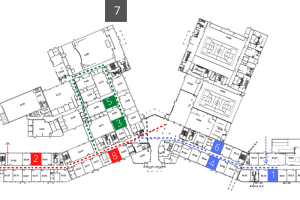One way or no way
September 22, 2020
The school has introduced one-way hallways in order to accommodate COVID-19 restrictions. Although there have been some complaints about the difficulties of the one-way hallways, they provide a safer environment, give students more time to reach out to teachers and allow for a more relaxed passing period.
Hallways have been set up with one-way directional signs. The downstairs hallways traffic flows toward D hall, while the upstairs hallways flow to B hall. Once the bell rings for the passing period, half of the students in every class are allowed to leave for their next class. The remaining half of students leave seven minutes into the 15 minute passing period. This means students are less likely to encounter face-to-face interactions because of the reduced amount of people in the hallways and the one-way flow of students, which helps reduce the spread of germs.
Students barely experience head-on contact with others with the set up of one-way hallways. In previous years, hallways have always been congested with students practically on top of each other trying to get to class. The idea of one-way hallways produces more space between students and provides a more socially distanced environment.
Because getting to class with the one-way hallway system in place takes longer, the school has allowed a 15 minute passing period instead of the previous five minute passing periods. Once students adapt to their routine and find the best route to get to their next class, students will have a good seven to eight minutes of downtime in between periods. With the extra time allotted, students have extra time to stop by a teacher’s classroom to ask a question or pick up an assignment. Or, students can simply use that time to take a break and prepare for their classes.
With school being on an A and B day schedule, reaching out to a teacher can prove to be slightly more difficult since students don’t attend all classes everyday. Since students only see certain teachers twice or three times a week, they have less face-to-face interaction with them and have to resort to email or Zoom for any questions, which provide a much more delayed response than simply asking a question in person.
Students are also used to the feeling of being rushed to get to class, go to the restroom, get water or talk to their teachers during the normal five minute passing period. The added 10minutes gives students time to follow the one-way rules and satisfy all of their personal needs. Not only do students no longer feel rushed, but this ensures that students are able to make the most of the time they are in class since they will not need to excuse themselves to use the bathroom or go to the vending machine. One-way hallways allow for a more healthy, secure setting to school and the 15 minute passing periods have allowed more time for students to navigate their way to class and take care of anything else along their way.



